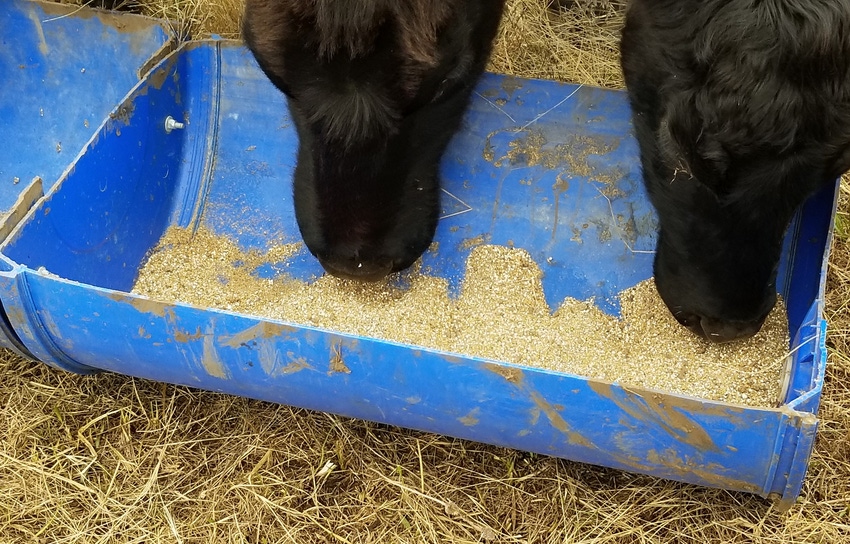
There was a time, it seems not too long ago, when talk of low-cost production and profit were common in the beef industry. Today, it seems not so much.
Instead, I see lots of talk about how “efficient” the industry is, when I cannot see that as truth. Much talk about meat quality as our primary goal, which also is misleading since we had good meat quality before the frame-size race and since we cannot produce any beef animal for long without healthy profits.
I could go on, but instead I want to tell you a little more today about my research on cheapening my winter protein supplementation for cattle on warm-season forages. As I have discussed before, protein is the major limiting nutritional factor in warm-season grass regions, especially in higher-rainfall areas that produce great amounts of forage but also high amounts of poorly digestible lignin and hemicellulose.
When I wrote of this last winter, I had found I could get an all-natural 38% protein cube nearby as the cheapest method for me to feed protein with my resources – meaning without spending a bunch of money on infrastructure and equipment.
Later in the winter, I experimented with a commercial urea/biuret product which comes in powdered form and is combined with a mineral package. I know of two such products, and there may be more. At any rate, despite the low cost of urea as a protein substitute, these products have a high cost per pound of effective protein delivered. I figure the product I was trying cost close to $1 per pound of effective protein, which is about twice what I paid for protein cubes, and about twice what I would pay for well-bought alfalfa hay as a protein source.
So I began talking to folks around the globe about homemade supplements based on feed-grade urea. Perhaps I should explain at this point that urea can be used in small quantities by the rumen flora to create various types of proteins to help make use of the dry, low-protein forage the cattle are consuming. In the US it is a common component in both dry tubs and liquid licks. Also, feed-grade urea and biuret are not the same chemical compound. Their chemical makeup is not the same. Also, feed-grade urea has lower digestibility and higher moisture resistance than fertilizer urea. Biuret appears to have a slightly lower digestibility yet and may have a little higher safety margin. This is actual one of the complex topics you should read about if you are researching the topic.
One of the most curious things for me early in my research was learning that the actual nitrogen component of urea (46%) is multiplied by about 2.8 to get the effective crude protein ranking. For example, if you have 100 pounds of actual urea in a mixture, therefore 46 actual pounds of nitrogen, it would have the effect of about 129 pounds of protein.
But to continue my story, with great care this fall I began using a South African recipe for a dry “urea lick,” which was shared with me by a friend in Colorado. Although my cows had been exposed to the commercial product last winter, I got them well-fed on conventional protein cake before offering them the lick. Then I poured it out in front of them while they were waiting on me to move them to new grass, and I watched them taste it to be sure none took any more than a few licks.
My report is that it’s working nicely and the cattle seem to self-regulate on it very well.
I won’t share the recipe here because urea can be deadly if mismanaged. But I will tell you there is a great amount of research on, and use of, urea supplementation in Australia and in Africa, as well as in North America. It’s apparently fairly common as a small component of some feed rations and supplements here in the US. You can find this information if you seek it diligently. One name you should know is Terry McCosker, a nutritionist from Australia.
I will also tell you that the mixture I’m using contains feed-grade urea to feed the rumen flora, some soybean meal as a bypass protein, as well as salt, bentonite, lime and a hint of sulfur. I buy the components and mix it myself. With only about 50 animals, this is not difficult. I keep the lick out with the cattle all the time, refilling it daily, and it is very easy to transport.
There are many caveats to the use of urea, such as the fact it’s probably safer for older animals, although little calves will also take a taste of the lick fairly regularly. Also, if cattle are severely short on protein, a urea lick will likely be insufficient. Examples of what I mean would be cattle lactating in winter on dry grass, or in some cases very large, hard-doing animals. Like any other protein supplement, a urea lick will increase consumption so anyone using it absolutely must have plenty of forage. In my opinion, a full rumen is the only safe location for a cow eating a urea supplement.
And one more warning: If protein is not what you need in your location, then urea or soybean meal or cottonseed meal or any other high-protein compound fails the economic test. Don't even consider it. You must know your forage deficiencies and your needs.
But for me, the happy news is that it’s cheapening back my wintering costs, alongside my use of high-density, controlled grazing. If you’re interested, start your search for information and learn what you need to know. There are nutritionists and feed mills that can help you, and you should read research and practical information on the internet until you’re blue in the face. This Australian website might provide a nice starting place.
About the Author(s)
You May Also Like




